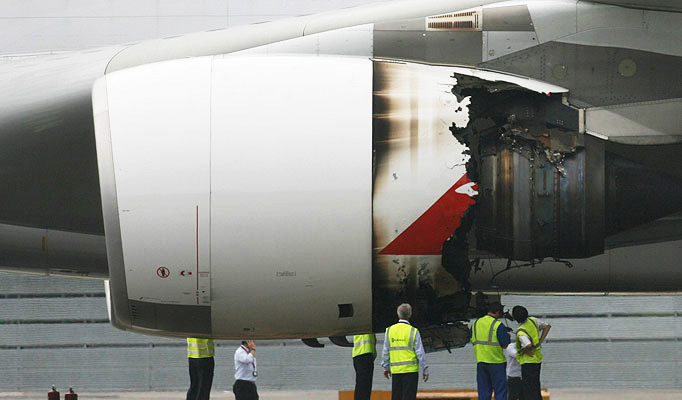
HARROWING details from air-safety investigators about the engine explosion on QF32 last month and new revelations about Qantas’s damages claim are intensifying pressure on British jet-engine maker Rolls-Royce.
It also emerged yesterday that Qantas has claimed that it will be ”uncommercial” to fly its A380s between Australia and the US while engine-thrust restrictions from Rolls-Royce remain in place.
It means the superjumbos will be able to carry only 80 passengers instead of the usual 450.
Advertisement: Story continues below
The airline has made the claim in documents lodged in the Federal Court against Rolls-Royce, which list the guarantees that the manufacturer gave as far back as 2000 about the Trent 900 engines.
The Australian Transport Safety Bureau yesterday handed down its first official account of the explosion on QF32, finding an oil fire inside one of its Rolls-Royce Trent 900 engines caused a heavy turbine disc to disintegrate and burst through its casing, severely damaging the aircraft and its systems.
In the past 48 hours, investigators have found a suspect oil stub pipe that was incorrectly made cracked, leading to leaking oil.
”Essentially, it was a manufacturing defect, or a potential manufacturing defect, in oil pipes in a number of Trent 900 series engines,” the bureau’s chief commissioner, Martin Dolan, said.
”The aircraft would not have arrived safely in Singapore without the focused and effective action of the flight crew.”
Five minutes after take-off on November 4, the thrust from QF32’s number-two engine started to fluctuate, and about 10 seconds later it exploded.
High velocity shrapnel tore through wiring and hydraulic lines to flight systems, knocked out the plane’s satellite communications and caused a fuel leak.
The damage triggered a barrage of alarms in the cockpit that took pilots almost an hour to respond to, investigators found.
The plane was overweight by 50 tonnes when it attempted to land in Singapore as damage to the fuel system meant the crew could not jettison fuel.
The flight computer indicated that the pilots could not apply maximum braking until the nose wheel was on the runway.
That left pilots with the prospect of being unable to stop the plane within the length of the runway at Changi Airport, raising the possibility of an aerodynamic stall if the plane came in to land too slowly, or a runway overrun if it came in too fast.
After the autopilot function faltered, the pilot in command, Richard de Crespigny, elected to fly the stricken aircraft in manually from 1000 feet.
He managed to get the main wheels down on the runway, the damaged front wheels down six seconds later and threw the No. 3 engine into maximum reverse thrust, pulling up the aircraft on the runway with just 150 metres to spare.
But the pilots could not shut down the No. 1 engine using either the emergency shut-off or inbuilt fire extinguishers as fuel continued to leak out, in the vicinity of hot brakes.
The findings come a day after Qantas was granted the right to sue Rolls-Royce for damages – believed to top more than $100 million – under the Trade Practices Act if it cannot reach a commercial settlement.
In a statement of claim released yesterday, Qantas has alleged that Rolls-Royce told it in 2000 and 2001 that the Trent 900 engines could take off using 76,000 pounds of thrust and had ”built in thrust flexibility” to power heavier superjumbos.
But it said advice from Rolls-Royce last month to operate the engines at a reduced thrust meant it would be ”uncommercial for Qantas” to fly between Australia and LA because the planes could carry just 80 passengers, compared to the usual load of ”up to 450 passengers plus freight”.
Even the latest engines to be modified by Rolls-Royce – known as the ”B” and ”C” versions – will not be able to be used on the LA route until the manufacturer and regulators lift the limitations on the thrust settings.
Qantas has been forced to use its ageing 747 jumbos on the LA route since it grounded its A380 fleet on November 4. Last week it put back into service two A380s on the Australia-London route after engines on the aircraft were changed.
Qantas has claimed that written advice from Rolls-Royce in 2000 and 2001 was ”misleading or deceptive” because the engines it bought contained a defect.
The airline said it was also told that the A380s powered by the Trent 900s would be able to be ”operated regularly and reliably on Qantas’ existing international routes … with a profitable payload and without the engines having to be replaced at any point before the end of the projected useful engine life”.
Rolls Royce declined to comment on Qantas’s legal action but said that the safety bureau’s findings were consistent with its recent public statements.






